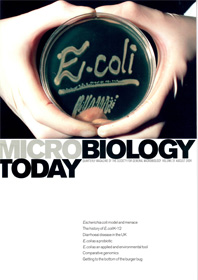Escherichia coli
01 August 2004 publication
The lead articles of the August 2004 issue of Microbiology Today are on Escherichia coli: model and menace; the history of E.coli K-12; diarrhoeal disease in the UK; E.coli as a probiotic; E.coli as an applied and environmental tool; comparative genomics; and getting to the bottom of the burger bug.
Escherichia coli: model and menace (p. 114)
Microbiology Today Editor and E.coli expert Gavin Thomas explores the various facets of E.coli.
E.coli K-12 (p. 116)
K-12 is possibly one of the most studied bacteria in science. Joshua Lederberg describes the fascinating history of this strain of E.coli.
E.coli as a cause of outbreaks of diarrhoeal disease in the UK (p. 117)
Many cases of gastrointestinal infection in the UK are due to various strains of E.coli. Henry Smith, Geraldine Willshaw and Tom Cheasty review the recent pattern of outbreaks and consider what action should be taken to protect us in the future.
E.coli as a probiotic (p. 119)
The use of probiotic microbes to improve health is becoming well established. Most of the bacteria in commercial preparations are Gram-positive, but as Bob Rastall and Glenn Gibson describe, E.coli may also prove to be a useful probiotic.
The use of E.coli as a tool in applied and environmental investigations (p. 120)
Much of the publicity surrounding E.coli is concerned with death and disease. However, for applied and environmental microbiologists, such as those involved in the water industry, E.coli is regarded as an extremely useful tool.
Comparative genomics of E.coli (p. 124)
As more genome sequences of different strains of E.coli are completed, researchers are finding a surprising variability.
EHEC 0157:H7 - getting to the bottom of the burger bug (p. 126)
E.coli 0157:H7 is a nasty human pathogen, yet it does not harm its cattle host. Dave Gally, Robert Quantrell, Stuart Naylor, Andrew Roe and Kevin Spears are finding out why.
Alexander Fleming is interviewed for the 1934 RAE (p. 130)
This is a long-lost transcript of the meeting between Alexander Fleming and his boss Almroth Wright about the forthcoming 1934 RAE to be submitted by the Inoculation Department at St Mary's Hospital, London.
The views in this humorous article are the author's and do not represent Society of General Microbiology opinion.
Going public (p. 138)
Vyv Salisbury reports on the exhibit and series of events set up to engage the public in dialogue with scientists and to showcase applications of microbiology research, in the At-Bristol Science Centre. Miriam Windsor writes about her experience talking to year five students about viruses. Sue Assinder reports back about the 6th Wrexham Science Festival and the Communicating Microbiology Workshop.
Gradline (p. 141)
The Society speaks to Gavin Thomas, a lecturer in the Department of Biology, University of York, about having a job in university research and teaching.
Schoolzone (p. 142)
Editor Gavin Thomas clears up the safety issues raised about using E.coli in school practicals. Dariel Burdass rounds up some recent microbiology education activities.
Comment - codes of practice in research (p. 156)
Some UK government bodies have recently issued a code of practice for research carride out by their fund-holders. Superficially this seems a good move, but as Tony Minson describes, the policy also heralds some pitfalls for microbiologists.
Cover image credit: Dr Jeremy Burgess/Science Photo Library

